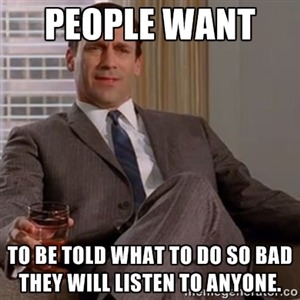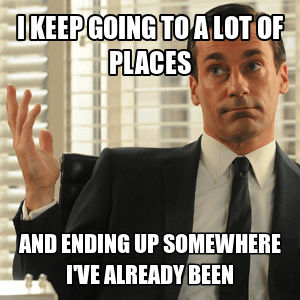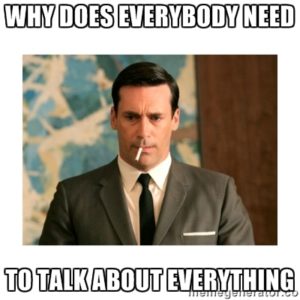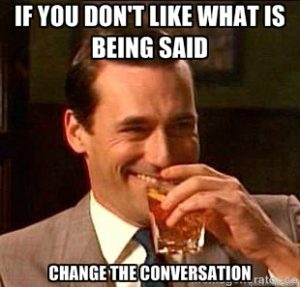You know the problem. We have been hijacked. Women, in particular, are conditioned by marketers to hate themselves. Female body image is owned by the mass media.
Billion dollar campaigns of fear have been waged for decades to get you to think you are inadequate. Because, in this state of mind, you need to buy things; cosmetics, dieting products, low calorie yogurt, and gym memberships.
A negative body image is good for business.

We sell stuff too.
Happy Human is in the business of providing fitness services. And if we were in it just to maximize profits, we probably should market with fear as well. We’d slather our site with skinny women with improbable physiques, before and after pictures, and big promises.
We’d do all this to get you to think that your body is inadequate and ugly. You might even be morally deficient for not working hard enough to acquire such a body.
But our company is “not just for profit”. Yes, we want to (and indeed have to) make a profit. But profit is just one of our company objectives. Another objective is that we want to, in some small way, reform fitness culture.
We strive to practice fitness without resorting to self-hatred as motivation.
And so, to make one small step in this direction, we present our guide on female body image and the mass media. We hope it is informative, entertaining and (above all) practical.
Body Image and the Media: Facts and Statistics
First we must define the problem and get to know, in intimate detail, what we are up against.
you need not fear the results of a hundred battles.” ~Sun Tzu
Rader programs, a provider of clinical treatment for eating disorders, has compiled a great list fact and figures. Here are some of the highlights:
- The most depressing: 4 out of 5 women in the U.S. are dissatisfied with their appearance.
- The most freaky: An estimated 10 million American women have an eating disorder. 2 million will die from complications resulting from this eating disorder.
- The most telling: According to the CDC, the average woman is just under 5’4″ and actually weighs 166lbs. The average model is 5’11” and weighs 117lbs. (Most of these models meet the Body Mass Index criteria used to diagnose anorexia).
- The most insane: Roughly one half of girls in 4th grade are on diets.
- The most daunting: The diet and diet-related product industry boasts annual revenues of $33 billion. This means the enemy is quite well funded.
- The most suggestive of a solution: Seven out of ten women felt angrier and more depressed following the viewing of fashion model images.
These campaigns take a toll on everyone. They fuel the anorexia and they fuel obesity. Because we are so dissatisfied with ourselves, we tend to eat more in order to feel better. Then when we get very overweight we go on a crash diet (which are proven to increase weight over the long-term).
In reaction to our negative body image we become violent to ourselves. We stuff, starve, hate, obsess about, and torture ourselves.
Enough is enough!
This is the 20th century equivalent of foot binding!
And it must end…
Female Body Image and the Mass Media: 6 Steps to Rescuing your Self-Worth
We are aware of the problem. And looking at the data we can see the danger of a negative body image. We cannot ignore it.
So what do we do?
We fight fire with fire!
We get to know how advertising works. We develop counter-measures. We use the techniques of advertising to rewire our habitual thoughts. We hire Don Draper as our personal body image consultant.
Step 1: Accept Vulnerability

The first thing we have to realize is that advertising works. And it works because it communicates with a part of the brain that we cannot access consciously or rationally.
Your mind is easily manipulated. But not to worry. Everyone who has ever walked the earth has this same problem.
The sooner we accept this limitation, the sooner we can make a strategy to limit our vulnerability.
The truth is, no amount of willpower is going to make you not crave an ice cream cone when you are confronted with a 20-foot-tall chocolate sunday on a hot day. And no amount of willpower is going to keep you from feeling, at least a little bit, inadequate in comparison to a super model.
Step 2: Protect yourself, Blow up the Access Points to your Mind

Next we must cut off access to our minds from those messages that are harming us. Keep a journal of all the messages you see or hear that try to make you hungry, or try to make you feel bad about yourself in comparison to others. Then write down how you can limit access to these advertisements.
This can be as simple as watching pre-recorded TV shows instead of live shows (watch out for TIVO as the advertisers are now making commercials that send messages even in fast forward). Maybe there is a show that makes you feel particularly bad that you decide to give up.
Get an in-home personal trainer instead of exposing yourself to the advertising bonanza that is the fitness gym (self-promotion alert!). Maybe when you fly on an airplane you simply shut-off the seat back TV and listen to a radio program on your iPod/iPad.
Tip: Seatback screens often don’t have an off switch but you can dim them until they are no longer visible.
Blow up the bridges. Protect yourself.
Step 3: Don’t buy it!

Here is a trick to use next time you find yourself tempted to buy a thigh master, a new miracle diet drug, or a book called “The Chimpanzee Diet: Bananas, Banana Pancakes, and Banana Burgers for a New You!”.
Recall the last time you made such a purchase. Remember how excited you felt when you purchased it. You were going to be fit, rich, sexy, powerful! Remember the excitement of the purchase, how you hid it away until you were alone, the unpackaging, and that first experience with the product. Magic.
And now remember how you felt about the product about 4-months later. Did you use it anymore. Were you better off? Would you buy it again? After a years time had you lost 50 pounds? Or were you heavier?
Why is this product that you are excited about today any different from all the products you tried in the past?
Realize that what you are buying is an experience of hopefulness. You are exchanging hope now for disappointment later. Don’t keep repeating, eternally, the same patterns that have kept you unhappy in the past.
Try something else!
Step 4: Become aware of and question self-talk

I don’t know Don, but we do. Talking to ourselves incessantly is a side effect of intelligence. And this self-talk can be your worst enemy.
Even when you have acknowledged your vulnerability, shut off crucial access points to your mind, learned to avoid the impulse buy, your biggest hurdle is still ahead of you.
The most influential salesperson in the world is yourself. You sell yourself things all day long, things that are totally unhelpful. You tell yourself you are ugly, inadequate, weak, incomplete, gross, fat, and stupid.
Do not let these messages drift through your mind without acknowledging and questioning them.
More Examples of Unhelpful Body Image Thoughts
“My face is starting to sag.”
“I have too much hair.”
“Look at my belly fat. I’m disgusting.”
“My house is a pig sty.”
“I’m not as fit as my sister-in-law.”
“Why is my body always against me?”
And the worst part is we cannot blow up this bridge. We are forever vulnerable to ourselves.
It is near impossible to control what floats up into your mind. But you can control how you react to what comes up. Don’t just accept the flotsam and jetsam that surfaces as gospel truth. Question it tenaciously!
Responding to Self-Talk
Flotsam: “My face is starting to sag.”
Response: “My face is changing. It is unreasonable to expect it to stay the same as when I was 20. It is different now and shows an air of distinction and confidence that wasn’t there 5 years ago.”
Jetsam: “Look at my belly fat. I’m disgusting.”
Response: “It is true that I would like to lose a little bit of my belly fat. But it is far too harsh to say that I am disgusting. I’m really a good person, with good intentions. My husband thinks I’m sexy, and there was that guy at the checkout line at the grocery that was flirting with me.”
You get the idea. Don’t let that little salesman in your head run roughshod over you.
Step 5: Change the Conversation

The conversation that the Mad Men want you to have is all about how your body looks. They want you to spend hours in front of a mirror with a miniature spotlight. They want you to catalogue every imperfection; every mole, every hair out of place, and every minuscule ripple of cellulite. When you scrutinize yourself in this way, you are ready to buy beauty and fitness products.
How you look in front of a mirror is a very small part of beauty.
There are many more important factors to beauty: how you move, your confidence, your mood, what you eat, how you speak, and how often you laugh. So change the conversation.
Here is one way to do so: Talk about what you would like to do instead of how you want to look. Focus on learning to dance the salsa, perfecting that Yoga headstand, or running your first 5k.
When you change the conversation from how you look to what you do you avoid a lot of the common problems that stem from a poor body image.
First of all, you won’t starve yourself because you can’t do anything fun while you are starving.
Second, you will be intrinsically motivated to do physical activity. This a fancy way to say that fitness will be fun. And because it is fun you will do a lot more of it! If you are focused on how your body looks then you begrudgingly workout for 30 minutes a day in order to achieve the extrinsic reward of improved physical appearance. You will get bored. And you will stop working hard if you don’t see superhuman results. Learning to have fun with physicality is the very best long-term fitness plan.
Third, you will have more confidence. If you are constantly analyzing how you look you will have a very hard time with confidence. The older you get the more you will struggle. If you focus instead on what you can do (you take up rowing or you climb your first mountain) then you have a memory of an accomplishment that will last a lifetime.
We are not saying you should ignore your looks. Just don’t obsess over them. Have fun, be physical, and the looks will come! But while you are waiting for them to come you may as well have a fantastic time.
Step 6: Accept setbacks as an Inevitable Part of the Process

This is the last step in the process. Even if you do everything right (you focus on doing something instead of being something, you carefully curate the flow of information entering your brain, and you learn not to beat yourself up) there will be setbacks. Perhaps an injury will prevent you from rollerblading. Maybe you gain 20 pounds over the course of year because of a stressful job situation.
Whatever happens, it is important to accept that setbacks are inevitable and there is often nothing we can do to prevent them. This is the time when your really have to practice changing the conversation in your own mind.
Instead of focusing on no longer being able to rollerblade maybe it is an opportunity to condition yourself to be able to do 10 pull-ups. Instead of beating yourself up because of weight gained look at the new weight on your body as a kind of early warning system. Your love handles are reminding you it is time to find a way to be less stressed, and more physical, at work.
It is often the setbacks that create the most profound change.
Want to help?
If you found this article entertaining and/or helpful and you’d like to help us spread the word here’s how:
- Link to this post from your website or blog. Perhaps you can mention it in a recent post of your own? Or if it would be useful to your own readers setup a link from a page. Please write jesse [at] www.happyhumanfitness.com if you need help. He’d be ecstatic to help you set up a link
- Share us on your favorite social media hangout using the buttons. We especially love Facebook likes and shares!
